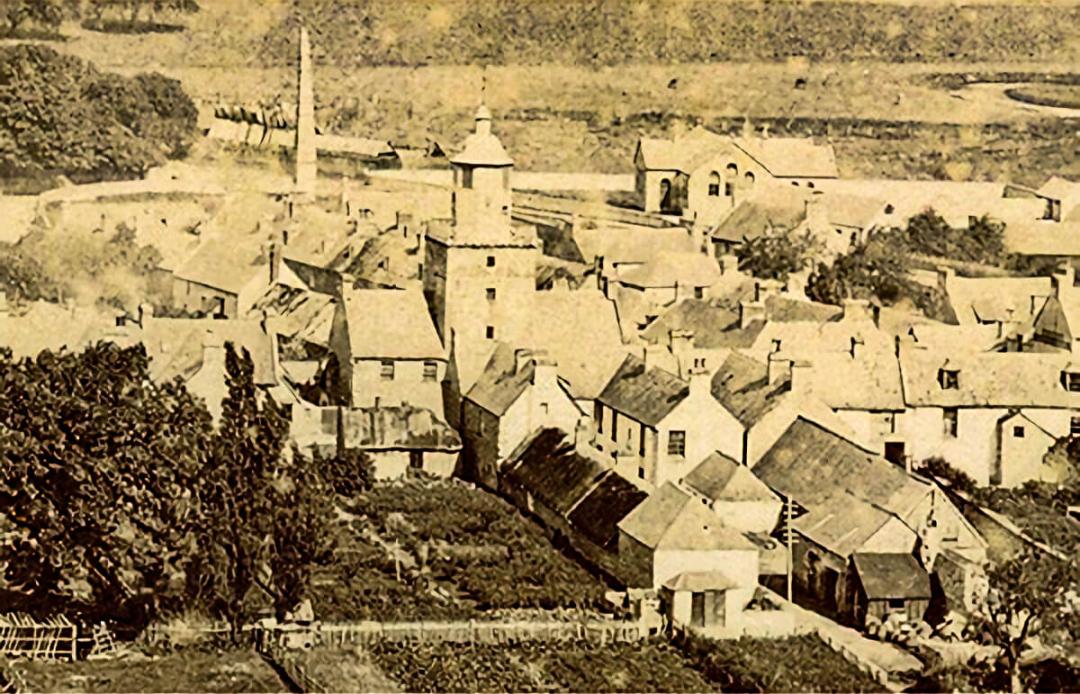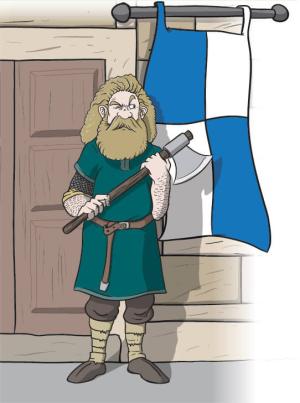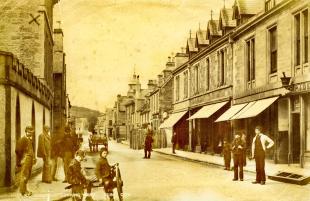You are standing on what was for many years Dingwall’s Market Square. In front of you is the entrance to the Town House or Tollbooth, built in 1733 for the Burgh Council headquarters and now housing Dingwall Museum. All that remains of the original building is the central tower.

On Burgh Business

The Town House was planned and erected to fulfil the need Council Chamber and a Burgh Court Room with entrance at first floor level while at ground level provision was made for a secure jail and for a Parish school. It is topped by a distinctive tower that gained its first clock in 1774, since replaced but which can still be seen (and sometimes heard) inside the museum.
When the overcrowded jail forced separation of male and female prisoners the parish school was removed to the new building, now 64 High Street, nearby. Later the Burgh Jail was amalgamated with the County Jail on Ferry Road thus ensuring prisoners could no longer escape as had occasionally happened from the town jail.
Right from the start the Magistrates held the Burgh Court sittings here and the Town Councillors met to decide on the business of the town: granting licences to trade, laying water piping, renting town properties, approving new building, gas and electricity provision. Every autumn the heritors and people gathered from the local area and neighbouring communities for the excitement of the annual elections. Until 1832 every few years councillors from here and the other four Northern Burghs met in the different burghs to decide on our MP.
The Carnegie Hall was added in 1906 with a dramatic redesign of the main entrance. And the town council was finally subsumed into the Highland Council in 1975.
Dingwall Museum
When the Highland Council took over in 1975 the Town House became the Dingwall Museum. To your left, the Museum’s modern entrance was once Frew's chemist’s shop, run by Williamina Frew, one of the first qualified female pharmacists in Scotland. In its windows now are the Conan cross-slab carved during the First Millennium AD and the Mercat Cross carved in the Second!
Around the Square

Across Church Street, is the 1780s purpose-built parish school at no 64. The pupils’ entrance was the doorway on Church Street. The upper floor schoolroom doubled as a Town Hall for large meetings and for entertainment events. The entrance on High Street led to the schoolmaster’s private dwelling house. It was here that Alexander Simpson lived as master of the school from 1782 until his death in 1821. Among the generations of schoolchildren in his care many went on to make their own histories, including his own sons Thomas, Alexander and Æmilius who explored and mapped the north of Canada. Æmilius planted the first apple tree in Vancouver and it is still there!
For much of the 20th Century it was the main building of Hugh A Ross the painter whose apprentices used to lodge upstairs and it’s now a charity shop and hairdresser.
Across the square you can see the pattern of tenement closes between or through buildings, originally giving access to private gardens or inn stabling. Inchvannie Court will now lead you to the next Trail signpost.
If you listen carefully, you might just hear the market noises selling, bargaining, shouting, laughing!
Further Reading
Norman Macrae: Romance of a Royal Burgh – Dingwall’s Thousand Years (1923/74)
Panel sponsored by Dingwall Museum
Do you know something we don't?
Please contact us if you spot an error here or on the panel, or if you have a suggestion for improving the information using »»» this form.

Once you have enjoyed your walk and learning more about Dingwall, you can donate between £1 and £20 by text towards the maintenance and development of the Heritage Trail.
Text DINGWALL to 70450 to give £3.
To donate any other value, add the digit/s: e.g. DINGWALL5 gives £5, DINGWALL12, £12. We, along with over 5500 charities across the UK, trust DONR to collect donations securely.
